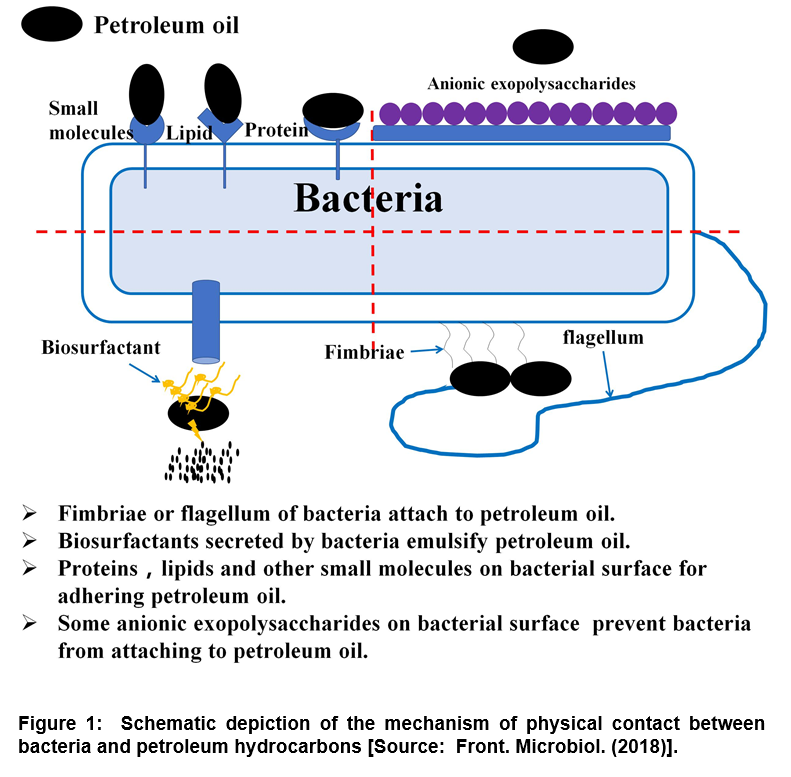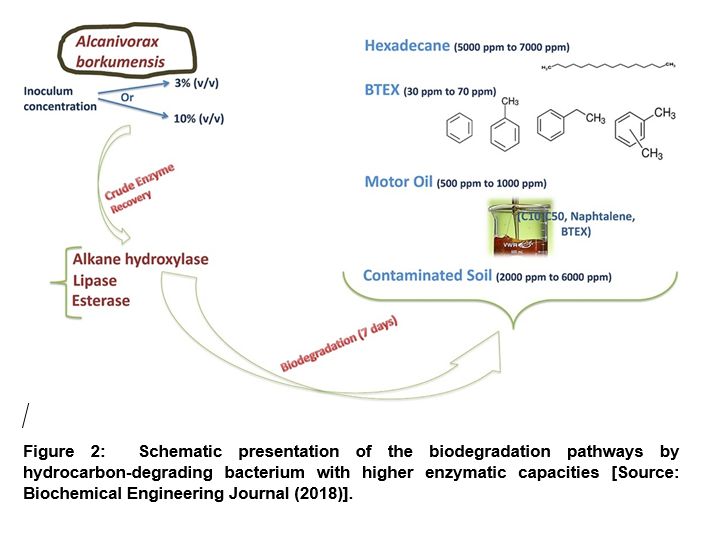Perspective
Oil Degrading Bacteria: Remediation of Environmental Pollution Resulting from Petroleum Hydrocarbons
Ishita Agrawal*
Department of Molecular and Human Genetics, Banaras Hindu University, Varanasi – 221005, India
Abstract
It is widely known that petroleum hydrocarbons constitute one of the most hazardous pollutants that affect human and environmental health. The ongoing research on bioremediation with petroleum hydrocarbon-degrading bacteria has shown tremendous promise of the technology due to its advantages of high efficiency and eco-friendly nature. To this end, studies have been carried out to identify a large amount of bacterial species with petroleum hydrocarbon-degrading ability for applications in bioremediation. Here, we present a brief perspective of some of the notable advances in oil degrading bacteria and the remedial actions for decontamination of water and soil along with recovering the spilled materials at oil sites.
*E-mail: ibeau.in1@gmail.com (Ishita Agrawal)
Article type: Perspective
Received: August 10, 2020
Revised: August 30, 2020
Accepted: September 10, 2020
- Introduction
Petroleum oil is recognized as an important strategic resource for nearly all countries in the world. It is commonly believed that the flourishing of the petrochemical industry is reliant on the anthropogenic activity and its energy demands. However, this comes with the growing concern of environmental pollution resulting from petroleum hydrocarbons with the rapidly rising population and modernization of our society. Research studies have suggested that the use of petroleum can result in environmental deterioration. For example, it is of major concern of oil spills from pipelines to tankers and their impact on the environment. These environmental disasters require very challenging decontamination efforts with massive investments of time and resources [1, 2]. This has accelerated the demand for remediation technologies to be developed that can mitigate the environmental pollution crisis.
There are several steps involved during petroleum production that involve storage and transportation, refining and processing. These steps often involve spills and discharges of petroleum hydrocarbons that occur as a result of blowout accidents during oilfield development. These accidents can happen as a result of leakage from oil pipelines and storage tanks, oil tanker and tanker leakage accidents, oil well waxing, and also during overhauls of refineries and petrochemical production equipment [3]. The available industrial techniques allow recycling or elimination of large spills to some extent. However, it is often very challenging to recover the spilled materials that remain in the affected area. This results in persistent risks to the environment [3].
Conventional microbial remediation technology has been employed for overcoming the challenge of petroleum hydrocarbons induced pollution. However, its practical application is hindered by many environmental factors that limit the large-scale application of the technology [1]. Therefore, while oil pollution is difficult to treat, researchers have focused on improvement of microbial remediation technology for developing a new method for the remediation of petroleum hydrocarbon pollution [4]. One such area is hydrocarbon-degrading bacteria that has attracted a great deal of attention. Researchers have studied such petroleum hydrocarbon-degrading bacteria that are found in nature for the bioremediation of petroleum oil-contaminated environments. They have found these organisms as promising candidates for the treatment of oil pollutants. To this end, bacteria have been screened and utilized to degrade waste products produced by the food, agricultural, chemical and pharmaceutical industries. The use of such bacteria to deal with environmental pollutants is considered a promising technology due to its low cost and eco-friendly nature [5].
- Bacteria Induced Biodegradation of Hydrocarbons
Studies have shown that bacterial surface properties are essential to the effective biodegradation of hydrophobic hydrocarbon substrates (Figure 2) [1]. Additionally, the adhesion mechanisms of these substrates are considered very important. This is due to the fact that adherence of hydrophobic pollutants to bacterial cells is enabled by hydrophobic fimbriae, fibrils, outer-membrane proteins and lipids along with small molecules that are present in cell surfaces such as gramicidin S and prodigiosin [6].

Researchers have employed a promising approach based on the application of surfactants to enhance the bioavailability of petroleum hydrocarbons. This approach is considered useful to enhance dissolution or desorption rates leading to the solubilization or emulsification of petroleum hydrocarbon pollutants [7]. Researchers emphasized on the selection of appropriate surfactants for pollution remediation and the prevention of secondary pollution [1]. For example, bioemulsifier-producing bacteria have been studied that have exhibited important physiological attributes. These include enhanced complexation and solubilization properties of non-polar substrates that promote the bioavailability. Bioemulsifier-producing bacteria also have superior affinity between cell surfaces and oil-water interfaces through metabolism that can promote deformation of the oil-water interface film [8].
In another study, researchers demonstrated an innovative approach based on a bacterium Alcanivorax borkumensis that was shown to feed on petroleum hydrocarbons. In this approach of bioremediation for degradation of hydrocarbons, enzymes were shown to be produced by the bacterium and their effectiveness was shown in degrading petroleum products in soil and water (Figure 2). These results pave the way for new breakthroughs for a simple, effective and eco-friendly technology for decontamination of water and soil at oil sites [9].
In this study, researchers used Alcanivorax borkumensis crude enzyme preparation as an agent for enhanced microbial hydrocarbons biodegradation in contaminated water and soil. This study confirmed the remarkable effect on the biodegradation with the crude enzymes by the inoculum and hydrocarbons concentration. Researchers showed the high enzymatic production reaching 145.71 U/mg for alkane hydroxylase, 3628.57 U/mg for lipase and 2200 U/mg for esterase. This subsequently led to a significant degradation efficiency of the different concentrations of petroleum hydrocarbon substrates reaching 73.75% for 5000 ppm of hexadecane, 82.80% for 1000 ppm of motor oil, 64.70% for 70 ppm of BTEX and 88.52% for 6000 ppm of contaminated soil. These results suggested that Alcanivorax borkumensis could be a potential hydrocarbon-degrading bacterium with higher enzymatic capacities for bioremediation of hydrocarbon-polluted environment [9].

- Concluding Remarks
Bacteria enabled bioremediation of petroleum hydrocarbon induced pollution is an active area of research due to its huge impact on the human and environmental health. It is anticipated that future studies will continue to focus on the theoretical aspects of the interfacial interaction mechanism between bacteria and petroleum hydrocarbons. Development of novel biocompatible surfactants is another research area that is expected to focus on new surfactant technologies to enhance contact between bacteria and petroleum hydrocarbons. In addition, new biotechnology routes can be explored to find new resources of petroleum hydrocarbon-degrading bacteria especially using high-throughput screening method to increase and enrich functional bacterial resources.
Acknowledgement
The author (Ishita Agrawal) greatly appreciates the postgraduate fellowship award by the Department of Biotechnology (DBT), Government of India.
References
[1] Xingjian Xu, Wenming Liu, Shuhua Tian, Wei Wang, Qige Qi, Pan Jiang, Xinmei Gao, Fengjiao Li, Haiyan Li and Hongwen Yu, Petroleum Hydrocarbon-Degrading Bacteria for the Remediation of Oil Pollution Under Aerobic Conditions: A Perspective Analysis, Front. Microbiol., vol. 9, 2018; DOI: https://doi.org/10.3389/fmicb.2018.02885.
[2] Xue, J., Yu, Y., Bai, Y., Wang, L., and Wu, Y., Marine oil-degrading microorganisms and biodegradation process of petroleum hydrocarbon in marine environments: a review. Curr. Microbiol. 71, 220–228 (2015). doi: 10.1007/s00284-015-0825-7.
[3] Wang, C., Liu, X., Guo, J., Lv, Y., and Li, Y., Biodegradation of marine oil spill residues using aboriginal bacterial consortium based on Penglai 19-3 oil spill accident. China. Ecotoxicol. Environ. Saf. 159, 20–27 (2018), doi: 10.1016/j.ecoenv.2018.04.059.
[4] Dvořák, P., Nikel, P. I., Damborský, J., and de Lorenzo, V., Bioremediation 3.0: engineering pollutant-removing bacteria in the times of systemic biology. Biotechnol. Adv. 35, 845–866 (2017), doi: 10.1016/j.biotechadv.2017.08.001.
[5] Guerra, A. B., Oliveira, J. S., Silva-Portela, R. C., Araujo, W., Carlos, A. C., Vasconcelos, A. T. R., et al., Metagenome enrichment approach used for selection of oil-degrading bacteria consortia for drill cutting residue bioremediation. Environ. Pollut. 235, 869–880 (2018), doi: 10.1016/j.envpol.2018.01.014.
[6] Zhang, X., Zhang, Q., Yan, T., Jiang, Z., Zhang, X., and Zuo, Y. Y., Quantitatively predicting bacterial adhesion using surface free energy determined with a spectrophotometric method. Environ. Sci. Technol. 49, 6164–6171 (2015), doi: 10.1021/es5050425.
[7] Varjani, S. J., and Upasani, V. N., A new look on factors affecting microbial degradation of petroleum hydrocarbon pollutants. Int. Biodeterior. Biodegrad. 120, 71–83 (2017), doi: 10.1016/j.ibiod.2017.02.006.
[8] Hou, N., Zhang, N., Jia, T., Sun, Y., Dai, Y., Wang, Q., et al. (2018). Biodegradation of phenanthrene by biodemulsifier-producing strain Achromobacter sp. LH-1 and the study on its metabolisms and fermentation kinetics. Ecotoxicol. Environ. Saf. 163, 205–214 (2018), doi: 10.1016/j.ecoenv.2018.07.064.
[9] Tayssir Kadri, Sara Magdouli, Tarek Rouissi, Satinder Kaur Brar. Ex-situ biodegradation of petroleum hydrocarbons using Alcanivorax borkumensis enzymes. Biochemical Engineering Journal, 132: 279 (2018), DOI: 10.1016/j.bej.2018.01.014.